|
What happens day by day, which is
repeated year after year, tells us about the traditions and customs of
Villafáfila. Some are still maintained without any variation, others
have modified part of their form but preserving the tradition, some have
disappeared, we will mention all of them.
SAN ANTONIO ABAD - SAN ANTON
On January 17, the day of San
Antonio Abad, patron saint of animals, it was a great holiday in the
town, a mass was held with the blessing of the animals, at the door of
the church mounted on donkeys, sayings were then read with themes
referring to what happened to the village People. Then dance. This
tradition is lost. Children still send each other drawings of animals,
especially pigs and donkeys.
|
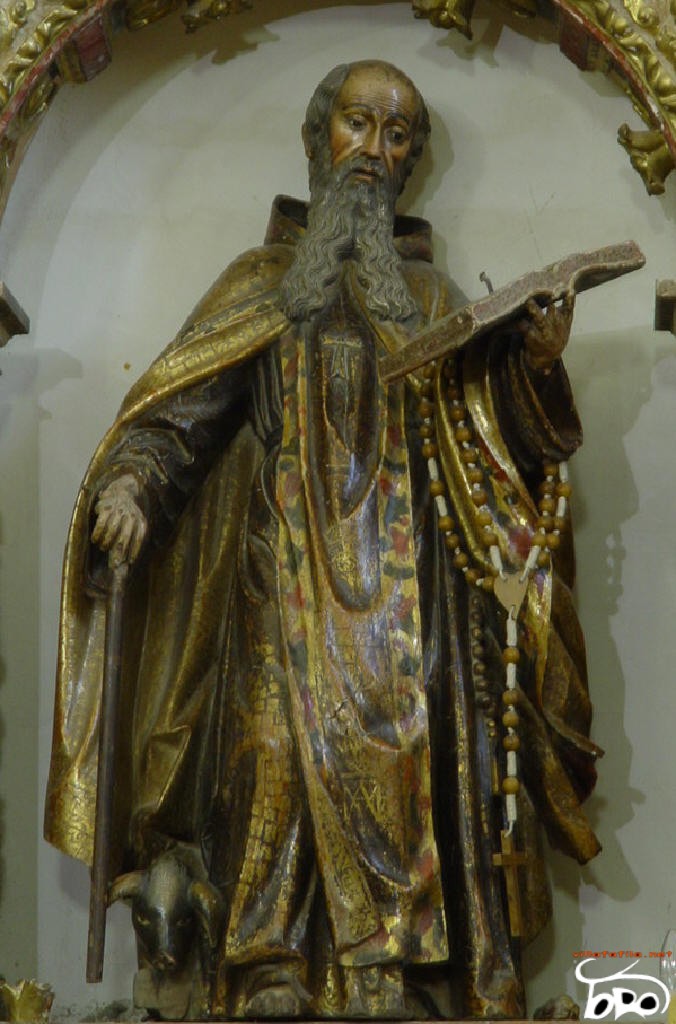
Saint
Anton Abad or Saint Aton |
THE COMPADRES AND COMADRES
It is a very peculiar celebration
and tradition of Villafáfila, especially one when he is little and goes
to school, because that day he does not leave. the compadres and
comadres are celebrated in the month of February, in Lent, on Thursday,
the compadres are held two weeks before Ash Wednesday, they are
performed by the boys and the comadres a week later by the girls. The
typical sweet is the Ears. That day is awaited with great enthusiasm and
a week before arrival the preparations begin, usually a great deal of
time is spent in the place where it is held.
Groups of boys or girls get
together, it is a day of coexistence, although you did not have to go to
school and get up early that day if you wanted, around ten o'clock you
stayed in the place, each person brought their chair and utensils for
eating, meals are raffled for each component one thing,. Breakfast is
usually a good hot chocolate accompanied by churros or biscuits at break
time to play soccer, the rest of the morning to visit other groups of
compadres, the food was always accompanied by a good dessert, some
custard or a flan, at that time the boys and girls who attended school
in the surrounding towns let them go out to visit their compadres, in
the afternoon they used to give sweets to the teachers at school, in the
afternoon snack, then well passing it between games until dinner
time, At most, one would stay until midnight when one would go
home. Normally there was leftover food that was usually finished the
next day by making a meal. On the day of the comadres a great desire of
the boys was to steal the snack from the girls. when one is not in
school, it is usually a dinner with friends.
|

Children
doing the compadres |
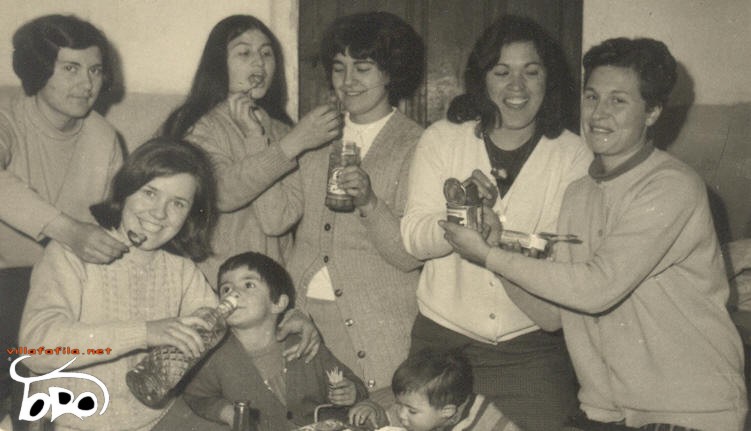
Women
doing the comadres |

Ears |
CARNIVAL
Carnivals are celebrated with
dances, people dress up, the burial of the sardine is made, making its
procession through the streets of the town, it is burned and a pickled
sandwich is eaten. The piñata dance was celebrated on Fat Sunday, where
the pineapple was broken, whose interior was full of candies,
chocolates, sweets, for tasting.
For many years the celebration of
the carnivals has been lost, but for years now they have been recovered
through the cultural association, where dancing is done, what has been
lost is the celebration of Fat Sunday.
|
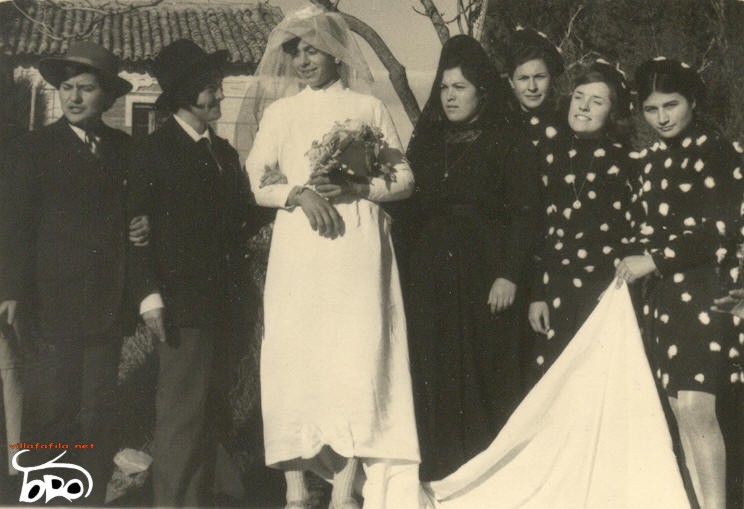
1970s
carnivals |

carnival
kids |

current
carnival |
HOLY WEEK
It is one of the most deeply
rooted traditions, it begins with the Blessing of the Palms and
procession in the afternoon, the auction of the Saints, who parade in
the processions, takes place on Palm Sunday after the afternoon
mass. The highest bidders would take the steps up for auction. The one
with the highest auction is usually Jesús Nazareno, due to the offers
made, throughout the year, in response to the requests made: healing of
illness, improvement of the harvest, result of an event, etc. The Urn is
the one with the lowest auction.

Palm Procession |
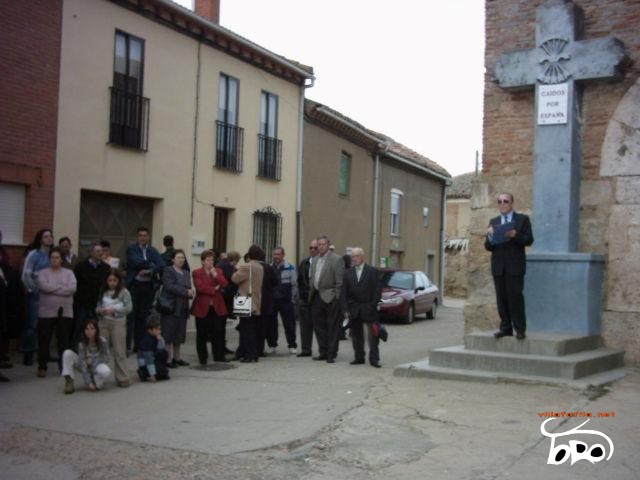
Image and Trumpet Auction |

the trumpet |
In addition to the liturgical and
processional celebrations, a preacher delivered the sermons, referring
to the different chapters of the Passion. Their number was eight, the
cost of which was paid by the City Council. The annual Paschal
Compliance Week also took place, so that the speaker's confessional was
attended by 90% of the citizens. the pronunciation of sermons has been
lost as and the number of the Paschal Fulfillment is much smaller.
Las Tinieblas was the peak moment
of the children's celebration, with their carracas and carracons.
The processional parades begin on
Holy Wednesday, with the only existing Brotherhood, that of Cristo de la
Misericordia founded in 1993, with dark green velvet suits, white cape,
gloves and sash, on its hood they carry a white cross , parading in
procession at night, in the procession of Silence, the brothers enter
the church in two rows standing on each side of Christ, carrying a
rattle and shears making them sound, a poetry written by D. Jacinto
Fuertes is read for this Brotherhood, the Forgive your people is sung,
and the Oath of Silence is taken to the brothers, in the town hall
square the Miserere is sung by the people of the town, at the end in the
church the Jesus Christ is sung.Throughout the procession, to remember
that you have to go in silence, the rattle and the shearing are
successively played.

Procession of Silence
(Brotherhood of Christ the Mercy) |

Procession of the Meeting
1929 |

Procession of the
Gathering |
During all the processions except
the one on Wednesday and Saturday night, a trumpet is accompanied, it is
played throughout the journey, with a harsh sound, making those days
peculiar, it is usually carried by the youngest of the town.
On Thursday afternoon the Ecce
Homo procession takes place
The night from Thursday to Friday
was one of great festivity, where they dedicated themselves to drinking
aguardiente, lemonade and chocolate with churros, people gathered in
groups with their local, something that has completely disappeared.
On Friday, the most awaited moment
of Holy Week takes place, in the morning the Procession of the
Encounter, parading Saint John, Mary and Jesus Nazareno, the latter
being the saint who is most devoted to Villafáfila, where the greatest
point is the moment of the encounter. of the images making first San
Juan bow to Mary and Jesus these returning her, during the procession
you can always see people going barefoot as penance for some promise to
Jesus Nazareno. Such is the devotion for him, that our ancestors have
been telling us the following event, in the early years of the 20th
century the parish priest wanted the sale of the image, and informing
the neighbors of it, a great tumult was formed, before the church of San
Martín, with danger of the integrity of the one who had to be guarded by
the Civil Guard.
One thing that has been lost in
this procession was the accompaniment of the preacher who said "run
Juan to see María" (which
the people continued saying "she
is waiting for you at Uncle Chafarría's door" )
at whose command the step of Saint John (who is not the Evangelist but
the Baptist, immemorial misunderstanding), people were aware of the
inclinations to see the state of those after hanging around at dawn.
In the morning they continue at
home having chocolate with churros for breakfast, at noon it is typical
to eat octopus.

Procession of the Holy
Burial 1942 |

Holy Burial "Recumbent
Christ in his Urn" "La Urna" |

Our Lady of Solead "La
Soledad" |
In the afternoon, the celebration
of the Holy Offices, the Nacre Cross is adored, according to tradition,
it had been sent from Jerusalem. Each leap year has a representation of
the Descent, which had not been represented for more than half a
century, it was recovered in the year 2000 by the Brotherhood of Christ
the Mercy, who are the ones that represent it. It consists of the real
staging of the descent, by means of the images of the crucifixion, the
Christ of the urn is placed, which is articulated, nailed to the cross,
on the other side Mary, is read at the same time doing what is said,
lowering it from the cross going to Mary, who with her head moving
recognizes her son Jesus, who is then placed in the Urn.
After the trades, the procession
of the Holy Burial, the Sorrows, the Urn and the Painful parade.
On Saturday night the procession
of Soledad, parades only the Virgen de la Soledad, accompanied only by
women, in line and with lanterns.
HARVEST OF CHAMOMILE
In mid-spring, chamomile is
collected, which is famous and of very good quality. It was mainly
collected by hand. This work was done by women and children, drying it
on blankets at the door of the collectors exposed to the sun. he made a
classic picture of local life, he cleaned himself, and he packed, it was
an income for the most modest classes. Until a few years ago, some
people continued to collect it for sale, at the Zamora fair, people
collected a little for their homes and some relatives.
|
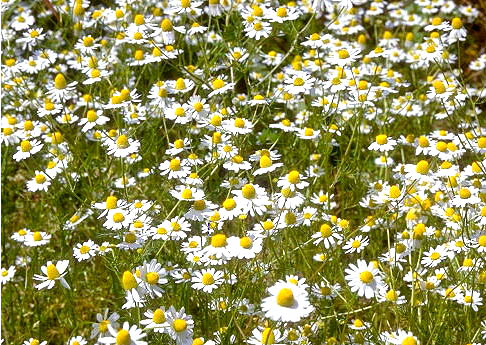
Chamomile |

chamomile drying |
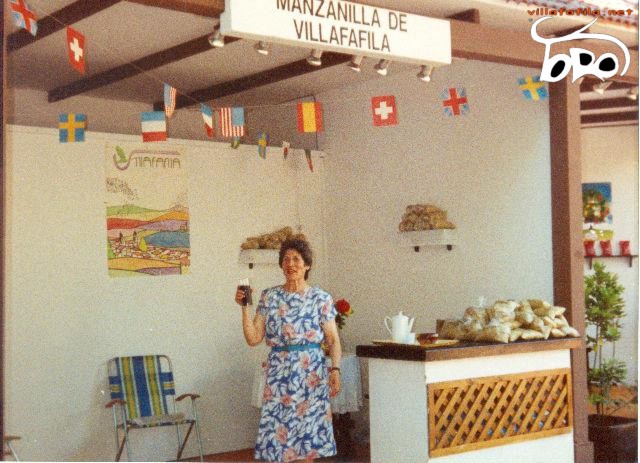
D.
Angelines Fernández, selling chamomile in San Pedro, Zamora |
THE FIFTH
The fifths are celebrated on the
eve of May 1st, this consists of when young people come of age you have
their party, they celebrate it, with a Castilian mass, where they are
dressed in the typical costume, then going around the bars, they do a
dinner, they dance for the whole town, they invite everyone to drink for
free, they put on the mayo, a doll that fills its interior with straw,
placing it on a beam as high as possible. Before, this festival was held
in December in La Purisima lasted a few days, there was a ribbon race
with horses that the fifths were taking out of a box, then May was
moved, over the years a large part of the tradition was lost, running
the tapes the dance, becoming only a dinner and refreshment, but since
the fifth of 1994 it has been recovering year after year.
|
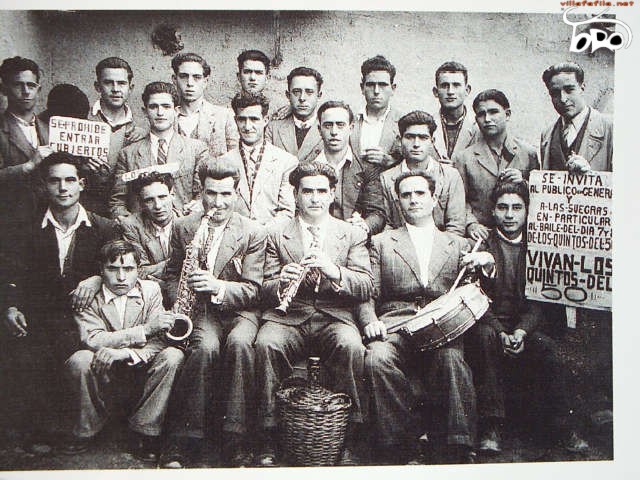
Fifths
of 1950 |

Quintos
celebrating the party |

current
fifths |
WORKERS' CHARITY SOCIETY
Every May, the Workers' Day party,
the party of the Sociedad Benéfico Obrera is celebrated, this society
was formed in 1913, "La Benéfica" as it is popularly known, it was a
workers' mutual aid union, in order to provide economic assistance to
mainly agricultural workers and shepherds in times of difficulty and to
subsidize the burial expenses of full members. and also attend the
funerals of honorary members, generally farmers and neighbors with a
better economic situation. As an emblem it has a flag with the national
heats, with an inscription that will say: SOCIEDAD BENÉFICO-OBRERA DE
VILLAFÁFILA. In recent decades, this company no longer provides its
work, but the company continues to be maintained, that each one of May
all its partners who are now all of the same condition,
|

Members
of the "La Benéfica" Workers' Benevolent Society of Villafáfila
with their flag |

Lunch of
the Workers' Benevolent Society "La Benéfica" of Villafáfila |
SAN ISIDRO LABRADOR
On May 15 and 16 San Isidro and
San Isidrín, the farmers' festival is celebrated. The Image of San
Isidro parades through the streets of the town with his car, approaching
the fields to bless them. These days you can taste the typical sweets,
(leaf buns, donuts, etc.), in addition to milk with rice and custard,
sheep and cow farmers distributed milk among their neighbors, to make
sweets. at night dance.
|

Procession of San Isidro Labrador, patron saint of farmers |

San
Isidro Dance |
THE FAIR
On June 18 and 19, the Fair took
place. They were days of buying the agricultural objects necessary for
the work of the summer: threshers, tornaderas, sales, slaughterhouses,
etc., clothing and footwear for annual use in the field were also
purchased. Banks, doors, kitchen utensils, etc. were also bought.
The City Council in full with the
painting of Santa Isabel, its patron saint, in fulfillment of its vote
of thanks from the town for having rid it of the plague, went to the
church of Santa María where a solemn religious function was celebrated.
The fair has completely
disappeared decades ago, all the aforementioned utensils have been
replaced by mechanical machinery, the City Council does not celebrate
its patron saint's day either.
SUMMER
It is the time of agricultural
harvesting that has undergone the most change, before they had the
harvest of said cereals with a sickle, but since the beginning of the
20th century the machine was introduced.
With the sheaves that formed these
the brunettes were made, this work was frequently carried out by young
women, who covered their faces and hands, so that the sun did not burn
them, it was an aspect of the Moroccan landscape, the main problem for
those was that at the next parties, young people would find them fresh
and rosy.
The hauling continued, preferably
carried out at night, the equipment and the mules that were to receive
the harvests were placed in the car, if the year was bad it did not go
too far, but if it was good, the car would even return with two laps.
The threshing and trellising, in
the threshing floor, gave rise to the formation of heaps and piles,
which were increasing in size every day. The cleaning was carried out by
wind, later going on to be carried out by machine. Cleaning and
acerendar were the two operations that had to be carried out so that the
grain was clean. This is how the mill was obtained.
The filling of the sacks, through
the emina and then the transport of the grain to the panera, constituted
the silage. The shears that at that time were put on the mules, which
carried the cart, gave it a sound and spectacle.
The snack of these cleaning days
was very classic, it consisted of a salad of cucumbers, green peppers,
tomatoes and onions, to which once these were consumed, wine was added
by some.
Next, the confinement of the
straw, so necessary for livestock, took place, for this, on the cart,
new armor and meshes were placed, different from the previous one in
order to increase its capacity, the straw thus transported, was carried
at the foot of the haystack where it was sold, through sales by the
bocarón.
The yield of cargo wheat per
quarter made the year good or bad, depending on whether it exceeded or
did not arrive, if the year was good the summer reached September, but
if it was bad it ended in the holidays or shortly after.
All this is no longer done today,
it has undergone a great change in the way it is done, due to the
introduction of mechanical machinery, as the years go by these machines
perform more tasks in less time, reducing the harvest to two weeks. .
The harvesting and cleaning of the
grain is carried out by the harvester, which also leaves behind the
tangle of straw, the grain is transported by trailers with greater
capacity every day, taking them directly to the bread baskets or to the
threshing floor if it needs to be dried.
The collection of straw has been
completely mechanized, first the tangles were converted with the baler
into small packages, which were then hooked to the trailer, by hand,
later in loadalpacas and put in the haystack or making meda, this work
needed several people , a decade ago with the introduction of
large-volume balers that make packages of about 250kg that are collected
with the tractor, with the shovel spikes, put in the middle, haystacks
are no longer used.
FRESH
During the summer and at night
with the good temperature you can see the neighbors sitting at the door
in all the streets, talking, always one of the busiest in Plaza San
Miguel (el Corrillo) this fact is said to be cool .
THE MELONAR
In the town there is a great
custom of planting melons, which bear fruit in summer, planting
watermelons, melons and sunflowers, as well as pumpkins and
cucumbers. Who in his youth did not go to "catch", some watermelon,
melon and above all what he called the most were the sunflowers, to go
eat them together with friends.
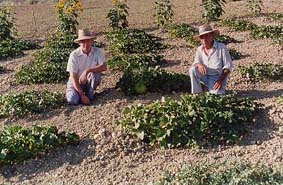
Melonar |
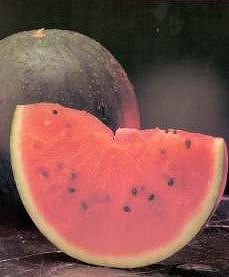
Watermelon |
SANTIAGO APOSTLE
One of the traditions linked to
the bulls was the custom of asking for them on Santiago's day at the
door of the mayor. The day before at night, the craftsmen and servants
who were in full harvesting task came to sleep at home and at night they
stayed to sleep in the threshing floors. On the 25th, people went out to
the streets with cowbells to ask for the bulls through the streets,
intoning couplets and songs composed for that purpose, with the rhythm
of jota
In 1950, when people gathered
asking for the bulls at the door of the mayor, Valentín Rodríguez, he
threw a piece of adobe from the window at the attendees and the show
ended.
This tradition has been lost,
although in recent years attempts have been made to recover it with
little success.
In the years that day a small
heifer was brought, released in the afternoon for the enjoyment of the
people, until the eve of the holidays, some years the young people of
the town took it out in the afternoon or on some night of the parties
for the street. I am no longer done due to the change in the law making
it impossible to take it out every day because of its expensive economic
price
OUR LADY OF THE ASSUMPTION AND SAN
ROQUE
It is the main festival of the
town that takes place on the 14th, 15th, 16th and 17th, the festival has
great bullfighting roots, the first bullfighting reviews that are had
are from 1506, at the time of the Catholic Monarchs, with the future
Over time, the celebration of activities and days has undergone changes,
in recent decades, the running of the bulls in the countryside usually
takes place a week before the start of the festivities on Sunday,
releasing two bulls, people going on horses, cars, and tractors.
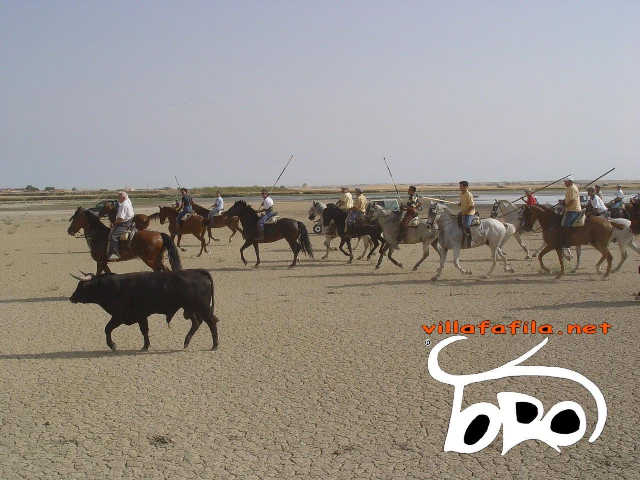
I
lock down the field |

parade |
On the night of the 14th, the
parade of supporters clubs was held, (which has now been held the day
before, with the supporters clubs joining together in a commission,
paying for the act themselves, after a few years of suspension). At
00:00, already becoming the 15th, the uncaging takes place in San
Marcos, a square is set up with iron fences that were previously made of
wood and around it is closed with trailers to prevent the escape of the
cattle and a place of vision for the people, where they are bullfighted
in the traditional style, making cuts facing the bull, with the suspense
of the possible catching, then a dance that is celebrated in the main
square until the wee hours of the morning.
On the 15th It is the day of Our
Lady of the Assumption, in the afternoon in the square the cattle are
released again, and at night there are fireworks, followed by the
festival.
The 16th is the day of San Roque,
when there is a mass in his honor and a procession through the streets
of the town carrying his image, in the afternoon there is a baseball
championship, and at night there is a festival.
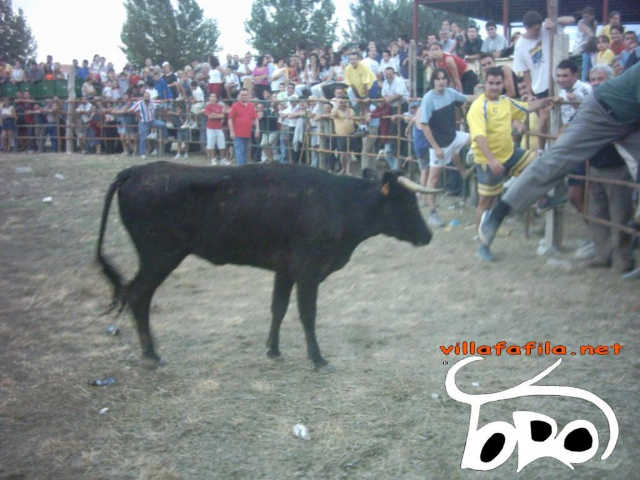
Heifer in the bullring |

dance of the night |
On the 17th, it is the day of San
Roquito, at the beginning of the 20th century, without specifying the
year, there was an occasion in which the consistory did not hire the
steers. The day of San Roque arrived in the morning and people crowded
with excited spirits at the door of Don José Santiago, Don
Pepe el Cervato , who
had to go out the back, jumping over the walls, to hire the steers that
They ran and fought on August 17, thus establishing the festival of San
Roquito. In the afternoon, a baseball championship and a festival at
night.
This usually happens every year
almost without any variation, but it is not the only thing, every year
other activities are carried out on those days, clay pigeon shooting,
painting exhibitions, theater, etc.
The days before the month of
August until the arrival of the festivities, cultural and sports
activities are organized, swimming championships, five-a-side football,
cycling, racquetball, children's games, etc.
In the last 25 there has been a
great boom in the clubs, they are groups of boys and girls, who spend
the days of the party together, in places, there are them of all ages,
since its inception its use has increased, it becomes among all a fee
for the purchase of drinks, already in many meals, for dinners or
lunches, and even real estate, the first years they had planks as
benches, some bags with straw, for the sleeping area, or...! , now there
are chairs, tables, even bus seats, practically all of them now have a
fridge, or some kind of cold room, each one has their own clothing to
differentiate themselves from the rest, they come in all colors, with
their drawing, 90% are stuck in some rock.
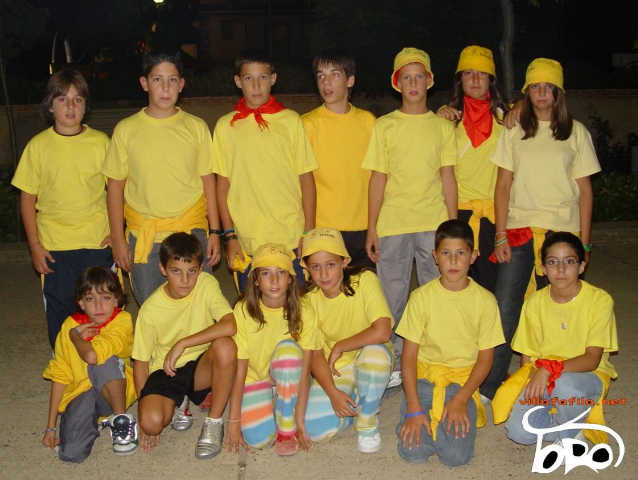
crag of children |
THE HARVEST
At the end of September the
harvest began, the grapes were collected and later transformed into wine
in the cellars. Some of these were carefully chosen to be hung, in
clusters, from the beams of bread baskets and pantries, for consumption
at Christmas.
It was done between songs that
made reference to local and current events, preferably to the departure
and return of the day.
The Lagarada was the culminating
moment of the harvest: a beautiful bunch of grapes was rubbed on the
face, sometimes also on the insides, of the chosen one, poor that young
man who fell into the hands of a gang of grape harvesters! His secrets
were public.
Today the harvest has totally
disappeared, like all the hawthorns that existed in the town, after the
arrival of the concentration in the early 1970s, after loss, the use of
the cellars too, passing to a great abandonment, today the use that is
given is for the realization of snacks between friends.
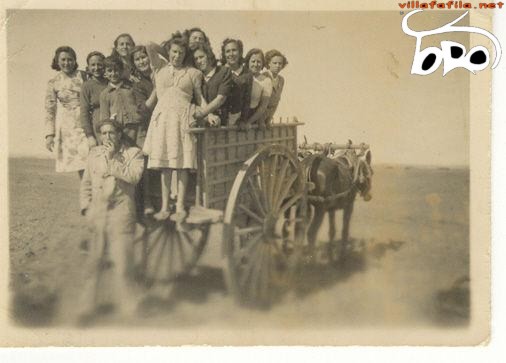
Vintage group of women and children |
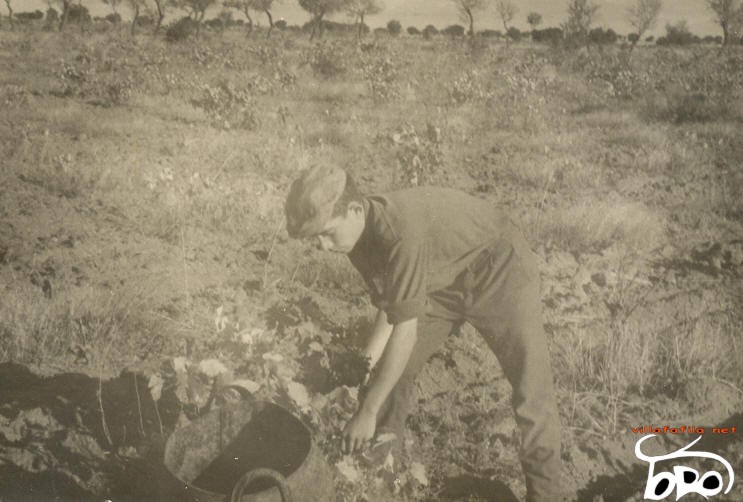
harvester |

Cellar with beam to make wine |
PLANTING
The sowing of cereals, after the
harvest from Pilar, began the new agricultural year, as we have
commented on the harvest, it has undergone a great change in the use of
instruments, from sowing by hand, to gradually introducing machinery ,
which is currently complete with larger machines every day, reducing
time, in the town there is a sorter for wheat and barley seeds, which at
the same time is limed for its protection, against animals so that don't
eat them.
HUNTING, GREYHOUND AND SHOTGUN
There are great fans, where the
hunting of the hare is combined with the greyhound, a fight in the race
and the shotgun that is also in search of the precious partridges,
"waiting" when the Geese (legs) leave and arrive at the lagoons.
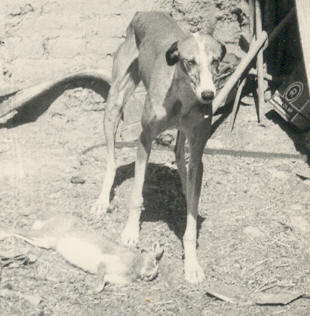
Greyhound with hare at his feet |
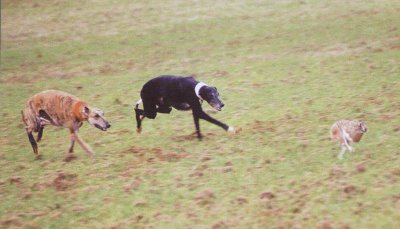
Greyhounds in the race behind the hare |
THE KILL
Between the beginning of December
and the end of January, the family pig is slaughtered, which gathered
the family and closest neighbors around it, the slaughter is done in
four days:
1st day: He was thrown on the
slaughter bench for his sacrifice where there were enough people to grab
him, always the smallest of the house was given the tail to hold, where
the butcher introducing the knife for his death and blood loss, the
blood was collected to make black pudding, then it was charred in straw,
then its skin was cleaned, it was opened in a carcass to remove the
interior parts, heart, livers to eat the chanfaina (liver and blood),
tongue, the intestines were cleaned for later be used to make the
chorizos, the butters, it was left in a place protected from the rain
but open so that it cooled down with the night's relent. The legs are
caught ears, the head is separated from the body.
2nd day: already well cooled, it
is quartered, separating its parts, loins, ribs, backbone, hams, bacon,
with the fats the coscarones are formed, later with these the typical
coscarón cakes are made, the chumarros are made, which are the first
fillets of the pork, the meat is minced, the base chichas of the
chorizos come out and salchichón is put in the slaughter baths,
separating the meat that is going to be used for chorizo (meat to
which spicy is added) or salchichón, Depending on the tastes of each
house, the chorizo is added more or less spicy.
|

bleeding
of the pig |

Pig
skinning |
3 day: the meat is left to rest in
the baths.
4th day: this is when the chorizos
and salchichón are made, these can be fat or thin depending on the
casing and are hung in bread baskets and attics of the houses to dry,
especially due to the frost at night, the first chichas are eaten (the
minced meat with Spicy) are heated in a frying pan, sometimes the blood
sausages are made from the tripe that is smoked in the kitchen on straw.
Once the slaughter was carried
out, the "sent" was carried out, so that family and friends could enjoy
the slaughtered pig.
This tradition has changed in some
aspects, the slaughter bench is no longer used for the sacrifice, now it
is hung from the tractor blades, nothing more than a couple of people is
needed. The burning is done with a torch. Mincing meat and making
sausages and sausages has gone from doing it by hand to incorporating an
electric motor into the machine, taking away a lot of work. It no longer
has as much family character due to the reduction of work, a large part
of the shipment has been lost. The casings are hardly used from the pig
itself.
The consumption of "oreado"
sausage soaked in wine and roasted has been lost, with the taste of new
wine from the cellars, an old and pleasant custom.
|

Chorizo
sausage and salami |

Sausages
tended to cure |
CHRISTMAS
Christmas is very celebrated,
those days when the family gets back together, after being separated for
much of the year.
Before dinner on Christmas Eve,
when one is a child, one goes out to ask for the bonus at home, with the
group of friends going from house to house singing Christmas carols
waiting to see what they would give as a tip, that there was everything,
going to those who gave the most first, then to the Christmas Eve
dinner, with the best dishes for the occasion, a good chat, toasting,
then some of the people go to a bar later to spend time with people
until the wee hours.
On the night of the 27th, the eve
of the Holy Innocents, you can always see the youngest preparing all
kinds of foolish things and pranks, who has not committed any?
On the 31st, he goes to eat the
grapes at the town hall, where he gives the twelve grapes and champagne,
for many years with connection to the door the sun was touching us D.
Ángel the ex-bailiff chime by chime, receiving the new year,
congratulating each other.
On January 5 there is a parade of
kings, which the children await with great enthusiasm, going around
their floats, throwing candies, making their offering to the baby Jesus,
then they distribute their gifts to the children of the town who wait
for them impatiently. Two decades ago they came on horses, many not so
children remember him going from house to house.
|
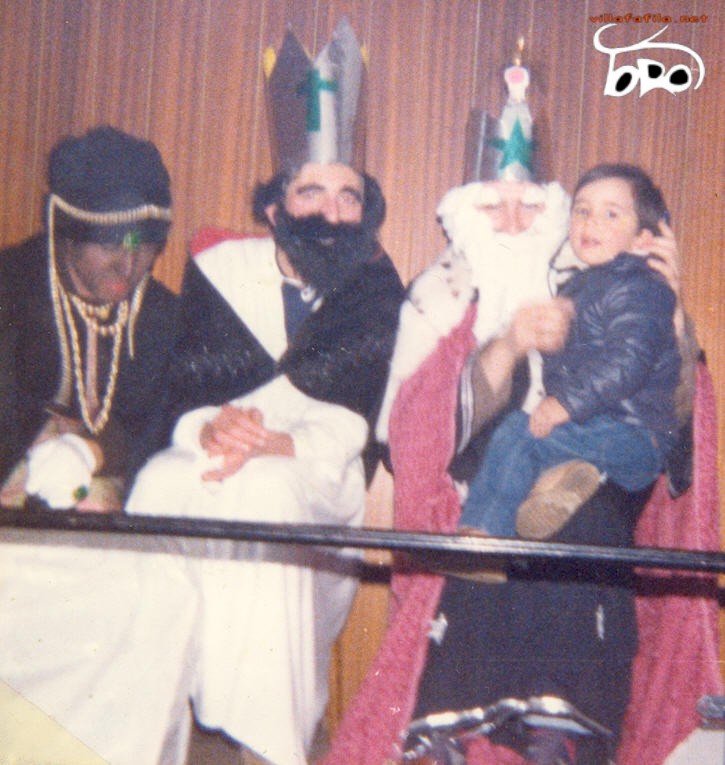
Kings
giving gifts to children, 1980s |
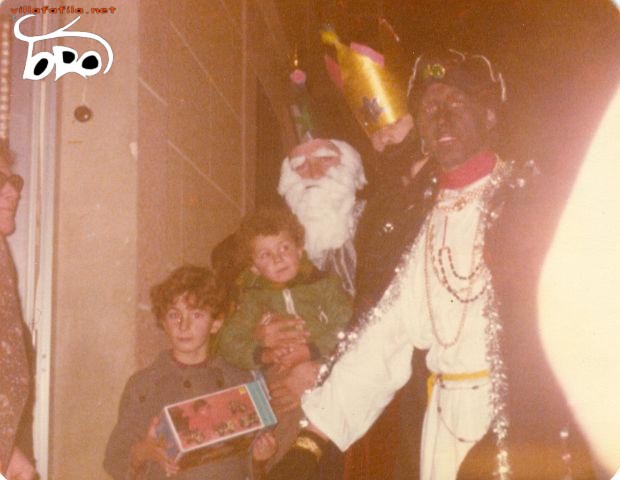
Kings
giving gifts at the door of the house, 1980s |

kings
today |
La Moma is a peculiar way to scare
someone, a gang of friends get together at night, dressing in sheets and
blankets all covered, going to wait for the person who appears from the
streets or alleys as they go home, In general, everyone is scared. No
less waiting for him some night he appears.
Author, text, photos:
Jose Luis Dominguez Martinez.
Transcription and montage:
Jose Luis Dominguez Martinez.
All text, photographs,
transcription and montage, the rights belong to their authors, any type
of use is prohibited without authorization.
All text and photography has been
authorized for storage, treatment, work, transcription and assembly to
José Luis Domínguez Martínez, its dissemination on villafafila.net, and
any other means that is authorized. |
![]()